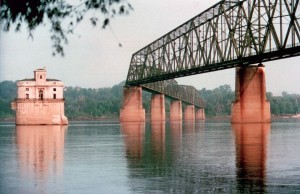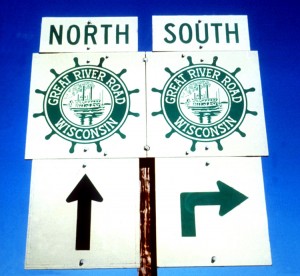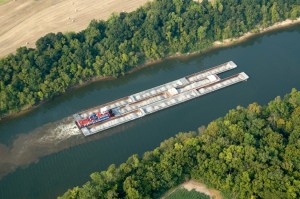 After recently crossing the flooded Mississippi River near Dyersburg, TN it got me thinking about the mighty river and the famous roads that follow it – namely, the Great River Road (GRR). The concept of the GRR was conceived in 1938 as a continuous road, but economic realities of the time dictated differently. At the time, there was no funding to build one continuous highway from Minnesota to the Gulf of Mexico, so they decided instead to link together a network of existing roads and fledgling highways that meandered and crisscrossed the river. Today, the GRR is a National Scenic Byway that travels nearly 3,000 miles and runs through ten states.
After recently crossing the flooded Mississippi River near Dyersburg, TN it got me thinking about the mighty river and the famous roads that follow it – namely, the Great River Road (GRR). The concept of the GRR was conceived in 1938 as a continuous road, but economic realities of the time dictated differently. At the time, there was no funding to build one continuous highway from Minnesota to the Gulf of Mexico, so they decided instead to link together a network of existing roads and fledgling highways that meandered and crisscrossed the river. Today, the GRR is a National Scenic Byway that travels nearly 3,000 miles and runs through ten states.
The entire GRR is marked with green and white signs with a river steamboat inside a pilot wheel (see photo). Along this famous road are 69 museums and historic sites, called Interpretive Centers, scattered throughout the ten states that border the river including Minnesota, Wisconsin, Illinois, Missouri, Kentucky, Iowa, Tennessee, Arkansas, Mississippi and Louisiana. The Mississippi River is the second largest watershed in the world, as tributary rivers and streams from 33 states and two Canadian Provinces end in the Mississippi. The river got its name from the Ojibwe Indians (also known as the Chippewa Indians), who called it Misi-ziibi, meaning Great River.
Traveling the GRR is a journey that offers culture, history, musical traditions, scenic beauty, food and hospitality. The road winds with the river through river towns, dense woods, spectacular bluffs, rich farmlands and the vast delta, where it finally drains into the Gulf of Mexico. Some people wonder about the folks who choose to live along the river and fight the 100-year floods and challenges that come with river life. I think that those people love the river like some drivers love being on the road. I applaud them for keeping that life, and all the history of the ones who went before them, preserved. Their spirit shines like the bright light on a tug boat or a barge, working at night on the Great River.
 Minnesota has the distinction of having the beginning of this famous river in its state, and with 575 miles, it also has the longest stretch of the GRR. Itasca State Park, which contains the headwaters of the Mississippi River, was established by the Minnesota Legislature on April 20, 1891 making it the first state park in Minnesota and the second oldest in the United States, behind Niagara Falls State Park. I have always wanted to visit Itasca State Park because, they say, it is a place where you can walk across the Mighty Mississippi! Talk about humble beginnings. Driving the GRR through Minnesota offers you some of the most beautiful scenery along the route.
Minnesota has the distinction of having the beginning of this famous river in its state, and with 575 miles, it also has the longest stretch of the GRR. Itasca State Park, which contains the headwaters of the Mississippi River, was established by the Minnesota Legislature on April 20, 1891 making it the first state park in Minnesota and the second oldest in the United States, behind Niagara Falls State Park. I have always wanted to visit Itasca State Park because, they say, it is a place where you can walk across the Mighty Mississippi! Talk about humble beginnings. Driving the GRR through Minnesota offers you some of the most beautiful scenery along the route.
Wisconsin boasts 250 miles of GRR. The GRR is Wisconsin’s only designated National Scenic Byway, with 2/3 of the road passing along or through protected natural areas. La Crosse is the largest city along the route and is home to the Grandad Bluff, a mesa with spectacular views. Crossing the river on I-90 can be quite a sight – especially in the winter when the bluffs are dripping with ice and the river is a frozen tundra. Like many of the bridges crossing this wide and awesome river, it is spectacular!
Iowa’s 326 miles of GRR has two places I’ve had the opportunity to visit and actually love. Dubuque is home to the William M. Black, an old dredge boat used during WWII that is now a National Historical Landmark. You can walk the decks of this 1934 steamer and tour its engine room and pilothouse. It is great fun (and very interesting) for the entire family. The bluffs in Iowa are stunning, and there isn’t anything like watching the sun set behind them while taking a dinner paddle boat ride on the river! The tiny town of Bellevue has a wonderful park at the top of the hill that overlooks the beautiful town and the lock and dam on the river in front of it. The name of the town, Bellevue, means Beautiful View, and if you have ever seen that view from atop the hill, you know how well the name fits this town.
Illinois has 550 miles of GRR, with part of that being a small piece of the original Route 66 in Madison. The Old Chain of Rocks Bridge (see photo) is the world’s longest biking/walking bridge, and offers great views of the river as an added benefit! Along old State Route 155, in Prairie Du Rocher, are some of the oldest buildings still standing in Illinois at the Fort de Chartres Historic Site, which was built in 1753. Illinois’ northwestern town of Galena not only has a rich culture, but it was also the home of Ulysses S. Grant.
 Missouri has one location that is no surprise – the boyhood home and museum of Samuel Langhorne Clemens (better known as Mark Twain), writer of the famous book “The Adventures of Huck Finn” about Huck and his friend Tom Sawyer’s adventures on the Mississippi River. Further south down the road (and river), I found a location that made me sad – Trail of Tears State Park near Cape Girardeau, Missouri. Located right on the river, the park is a memorial to all of the Cherokee Indians that died while being “relocated” to Oklahoma. Nine groups of Cherokee Indians crossed the river at this point in the winter of 1838 and 1839 – and many of them did not survive.
Missouri has one location that is no surprise – the boyhood home and museum of Samuel Langhorne Clemens (better known as Mark Twain), writer of the famous book “The Adventures of Huck Finn” about Huck and his friend Tom Sawyer’s adventures on the Mississippi River. Further south down the road (and river), I found a location that made me sad – Trail of Tears State Park near Cape Girardeau, Missouri. Located right on the river, the park is a memorial to all of the Cherokee Indians that died while being “relocated” to Oklahoma. Nine groups of Cherokee Indians crossed the river at this point in the winter of 1838 and 1839 – and many of them did not survive.
Kentucky has only 63 miles of GRR, but this is the place where the Ohio River drains into the Mississippi, which right now is part of the flooding problems downstream. Columbus, KY is the place where the Union’s Western Campaign and General Ulysses S. Grant fought the first battle of the Civil War, known as The Battle of Belmont, in 1861 (the Confederate soldiers worked hard to fortify the bluffs along this portion of the river). Traveling this byway is like entering a time machine – it takes you back to a time when frontiersmen were looking for a way west, but instead found their way south, to the Gulf of Mexico.
Tennessee’s entire 185-mile western border is marked by the Mississippi River, and here the GRR winds through some of the most scenic stretches of the lower valley. Along the way, you will see the jagged Chickasaw Bluffs, small scenic towns, the forested park at Fort Pillow, and more. The GRR passes along several lakes and four state parks before finding its way to the bustling town of Memphis, which is filled with all sorts of riverfront (and other) attractions.
The Mighty Mississippi flows along the entire western boundary of the state of Mississippi, and after years of floods, the area there has some of the richest farmland in the country (I guess that is a positive that comes from a negative). Just south of Memphis, in the northern portion of the state, you’ll find Tunica Riverpark & Museum. While there, you can enjoy a sunset walk along the river, tour the museum, or take a dinner cruise on the luxury Tunica Queen ship. Further south, Vicksburg National Military Park commemorates the campaign, siege, and defense of the city of Vicksburg. The city’s surrender on July 4, 1863, along with that of Port Hudson, LA on July 8, split the South, giving control of the Mississippi River to the Union during the Civil War. If the research I did is right, Mississippi, the state, was named after the river – not the other way around.
 Louisiana has amazing plantations along its section of the GRR that are some of the best preserved remnants of that era. Some of these plantations, built in the early 1800’s, are nestled between groves of huge oak trees that are 300 years old (see photo). I was amazed at how much Civil War history I discovered while looking into the GRR in Louisiana. I never would have guessed that so much happened in Louisiana and Mississippi (and all along the river). Flowing through Baton Rouge and then down to “The Big Easy” (New Orleans), the GRR is littered with all sorts of riverfront attractions. Famous for its food and music, you will find plenty of both along the way. New Orleans is the end of the ride down the Mississippi and the GRR, as the Great River spills into the Gulf of Mexico.
Louisiana has amazing plantations along its section of the GRR that are some of the best preserved remnants of that era. Some of these plantations, built in the early 1800’s, are nestled between groves of huge oak trees that are 300 years old (see photo). I was amazed at how much Civil War history I discovered while looking into the GRR in Louisiana. I never would have guessed that so much happened in Louisiana and Mississippi (and all along the river). Flowing through Baton Rouge and then down to “The Big Easy” (New Orleans), the GRR is littered with all sorts of riverfront attractions. Famous for its food and music, you will find plenty of both along the way. New Orleans is the end of the ride down the Mississippi and the GRR, as the Great River spills into the Gulf of Mexico.
I learned so much doing the research for this story but there is much more to learn. If you are interested, I recommend that you search “The Great River Road” on the internet. You will find all sorts of websites, pictures and links that will give you much more information than I have presented here. I think it would take years to see all of the little (and big) towns, cross all the bridges, ride the riverboats and ferries, visit the museums, and enjoy all of the vistas along this wonderful scenic route. There are so many places that I want to see, now!
The Mississippi is still a working river, filled with barges of grain and all kinds of commodities going up and down the river (see photo). The Port of New Orleans is the 6th largest port in the U.S. and has the longest wharf in the world, which is two miles long. In the fall, there are exciting cruises to enjoy the awesome foliage on the bluffs along the river. Plan a vacation and enjoy the fun and history this jewel in the middle of our country has to offer. And if you are a driver and you get laid-over near any of these sights, it would be well worth the trip.
NOTE: As the Mississippi River is currently experiencing some of the worst flooding ever due to excessive amounts of rainfall and snow melt, our thoughts and prayers go out to everyone affected. Hopefully, when this is over, all of the pieces of the Great River Road and the sights along its route will be open and accessible (and undamaged) – especially the historical sites that can’t be replaced if lost. And remember, if driving anywhere near the affected areas, never drive into deep or fast-running water – turn around and go another way, or just wait until the road is clear. It is just not worth the risk!

1 Comment
Thank you for this outstanding article. I also love the Great River Road even though I have not traveled the whole route or route. This brought back memories of stopping in Alma, Wisconsin on the River. I ate lunch in a cafe while looking out the windows at the locks right there. Fantastic visit and memories. The people there are so nice.
Thanks again for bringing back memories of this historic road.
Uncle Darrell